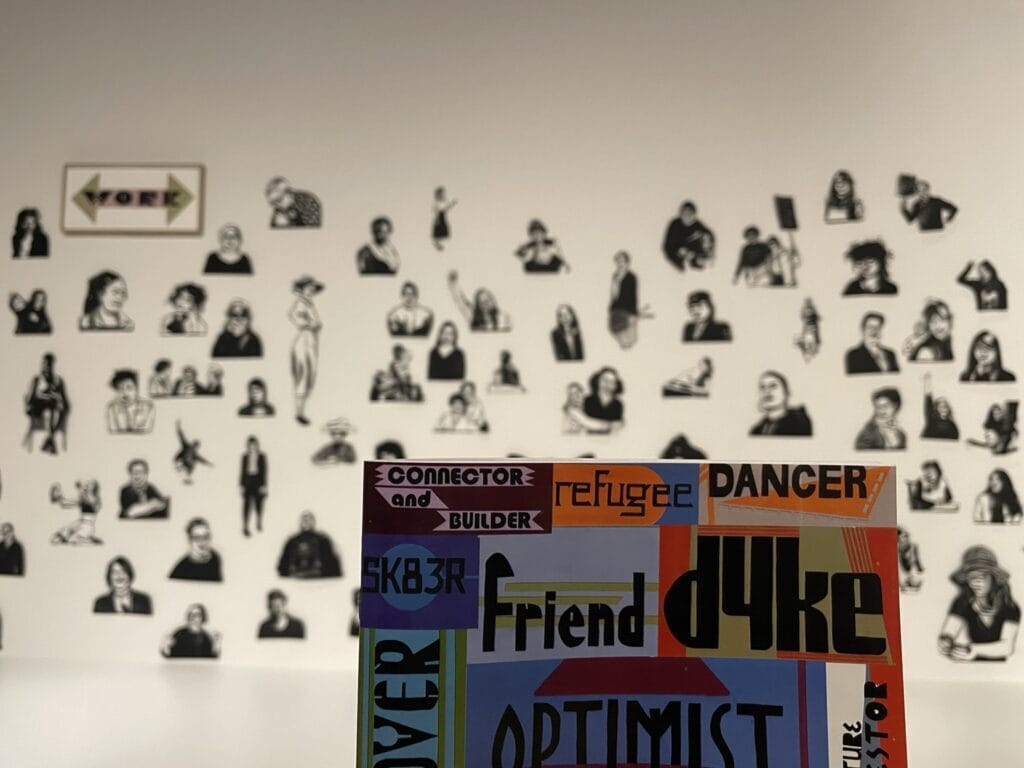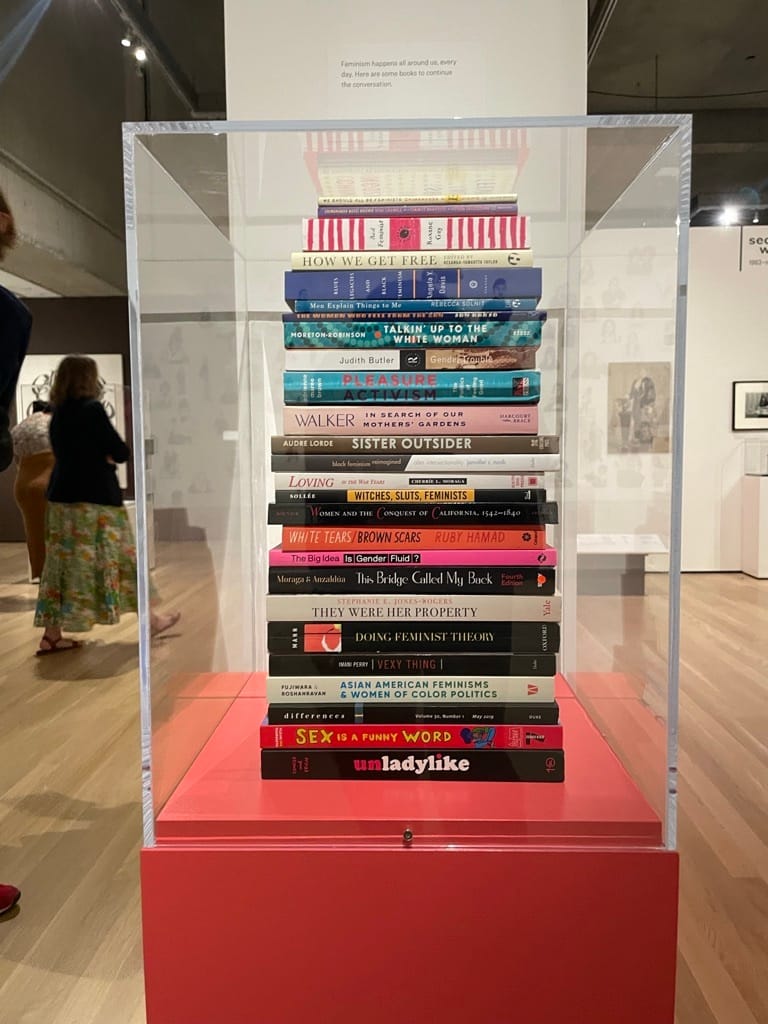
Cut portraits against the “Hella Feminist” guidebook which showcases local feminists
If you dug through the Oakland Museum of California’s archives, you would probably find material ranging from the sublime to the completely bizarre. One of the more odd finds in recent years was a poster featuring what one curator thought to be a rotary phone dial: it was actually a container for The Pill. The archival error, while humorous, underscores a historical lack of diversity in most museums’ staff.
Determined not to make the same mistakes as their predecessors, Carin Adams, Lisa Silberstein, and Erendina Delgadillo decided to curate a new kind of museum experience. They worked with community activists, academics, and artists to create an intersectional and introspective project with a Bay-Area spin. Over two years later, their work was unveiled as the Hella Feminist exhibit at the Oakland Museum of California (OMCA).

Detail shot of an art installation at “Hella Feminist” which showcases powerful local feminists – photo by Katy Atchison
“One partnership we’re particularly grateful for is working with the Church of Black Feminist Thought,” recalled Delgadillo, Hella Feminist’s consulting curator. The Church was founded a few years ago by two Berkeley PhD students Ra Malika Imhotep and Miyuki Baker. The Hella Feminist curatorial team invited Imhotep and Baker to “complicate” our linear, mainstream understanding of feminist history.
After combining materials from OMCA’s archives with their own knowledge and resources, The Church contributed a section on Katherine Smith to the exhibition. Smith was a formerly enslaved Black woman living in Oakland. Reading her story, visitors are reminded to uplift perspectives that were—and continue to be—marginalized by many exclusionary or ignorant women’s rights activists.

Womens Peace Camp – dgitized for the Oakland Museum of California
“We’re so fortunate for the opportunity The Church gave us for them to complicate our institutional voice,” Delgadillo said.
In addition to scholars, the Hella Feminist exhibition team also worked with artists. From a giant, multimedia tapestry to performance art pieces, the art featured in this exhibition is sure to inspire, educate, and challenge viewers.
“The exhibit has a lot of incredible artwork,” said Hella Feminist co-curator Carin Adams, who also serves as OMCA’s Curator of Art. She mentioned WORK, designed by nationally-recognized creatives Miriam Klein Stahl and Kate Schatz.

“Patty’s Crew” by Shizu Saldamando
“It’s a multimedia piece that features 200 feminists, many of them from the East Bay, and it’s just fantastic,” described Adams. Stahl and Schatz created the multimedia art installation to highlight feminists “whose work is important but not always acknowledged.” From familiar names like Alice Waters and Angela Davis to lesser-known activists like Nenna Joiner and Denise Brown, WORK reminds us to know about, encourage, and join the activism that’s done in our streets and backyards.

Suggested reading material
In addition to contemporary activists, Hella Feminist also highlights events and people important to feminist history from California’s past. The fight for gender equity in the Bay Area differed from that in other places, both abroad and within the U.S. For example, an increase of women in the workforce during WWII is one of the most well-known milestones in feminist history. Hella Feminist highlights the specific impact of working women on Richmond’s shipyards during this time.
It details that the history and legacy of this change precipitated consequences that impact the city to this day. Visitors will see a similar regional connection in a section about bodily autonomy. The exhibit points out that Oakland’s International Boulevard is a huge human trafficking hub. Coupling statistics with informational graphics, the exhibit makes an issue so geographically near to us, hit close to home emotionally. Learning about what has happened—and what’s to come— in our communities makes us more likely to feel connected and get involved.

Portrait of Toni Stone – the first of three women to play professional baseball full-time
Hella Feminist covers a lot of ground, but it doesn’t promise to tell the complete story of feminism. What it does promise are introspection and inspiration.
“This exhibition is a feminist response to this moment,” explained co-curator Lisa Silberstein. “We hope that visitors experience a range of emotions: grief, amusement, and humor—and there’s also hope.” Hella Feminist is a chance for us to question: what is my relationship with feminism? How does it intersect with other identities I hold? It gives us space to consider recent infringements upon reproductive and gender-affirming rights. It reminds us of our Bay Area feminist heroes and introduces us to new ones. Peppered with thought-provoking questions, you’ll linger a little longer in front of an old dress or faded poster and think about what these pieces of history mean for the present—and the future.
The exhibit was designed to be remembered. Unlike taking a final at the end of the semester, your relationship with the material won’t end when you leave the museum’s halls: with physical takeaways, a reading list, and loads of inspiration, you’ll have enough propaganda to empower you to be the 201st feminist on OMCA’s walls.

Digitized for the Oakland Museum of California
The post “Hella Feminist” Debuts at Oakland Museum of California appeared first on Broke-Ass Stuart's Website.









